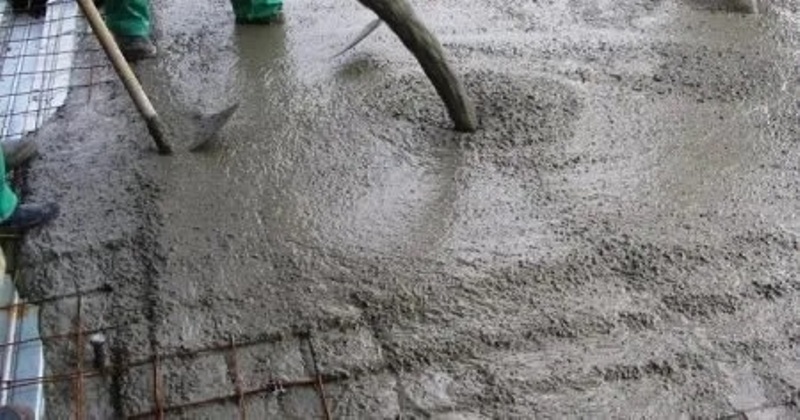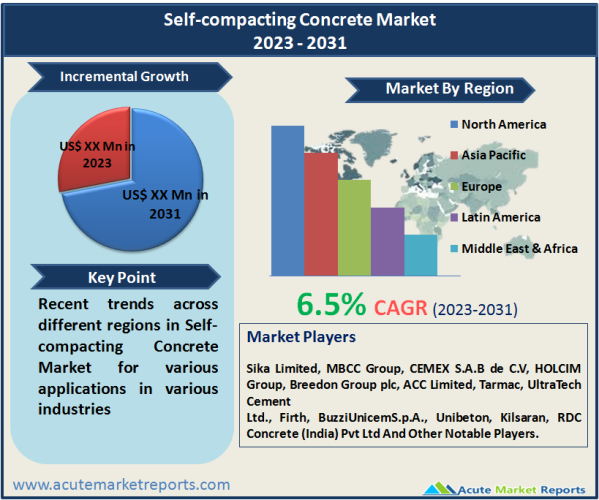
Self-compacting concrete (SCC), also known as self-consolidating concrete, is a specialized type of concrete that possesses unique properties, particularly in terms of flowability and ease of placement. SCC is designed to flow and fill complex molds and formwork without the need for external vibration or compaction, ensuring that it self-levels and achieves full compaction on its own. This innovative concrete mix has gained popularity in the construction industry for its numerous advantages, making it ideal for various applications. The self-compacting concrete market is a dynamic sector within the construction industry, characterized by innovative solutions that simplify concrete placement and improve overall construction efficiency. Self-compacting concrete market is estimated to grow at a CAGR of 6.5% from 2025 to 2033.

Self-compacting concrete (SCC) market isdriven by its versatility, labor-saving benefits, and suitability for sustainable construction practices. While cost considerations and material sourcing pose challenges, the long-term advantages of SCC are expected to outweigh these restraints. As the construction industry continues to evolve with complex designs and sustainable initiatives, SCC is expected to play a pivotal role in enabling innovative projects. The market's growth will also depend on the development of cost-effective formulations and the establishment of a robust supply chain for SCC materials. As the market progresses into the forecast period from 2025 to 2033, it is expected to witness continued expansion and technological advancements, making it a promising sector for investment and development.
Enhanced Workability and Labor Savings
One of the primary drivers of the self-compacting concrete market is its exceptional workability, which eliminates the need for vibration during placement. SCC is designed to flow and spread effortlessly within formwork, ensuring that it fills all voids and conforms to complex shapes without the need for mechanical compaction. This characteristic significantly reduces labor requirements, as it eliminates the physically demanding and time-consuming task of vibrating concrete. In 2024, the construction industry witnessed increased adoption of SCC, leading to substantial labor savings and improved construction timelines. Contractors and builders have increasingly turned to SCC to streamline their construction processes, reduce labor costs, and achieve higher levels of productivity. This trend is expected to continue into the forecast period (2025-2033), driving the growth of the self-compacting concrete market.
Increased Focus on Sustainable Construction
Sustainable construction practices have gained prominence globally, driven by concerns about environmental impact and the need for energy-efficient structures. SCC plays a vital role in sustainable construction due to its ability to reduce waste and minimize environmental disturbance. SCC's precise flow characteristics allow for the optimal use of materials, resulting in lower waste generation and reduced environmental footprint. Additionally, SCC's ability to produce aesthetically pleasing and durable concrete finishes without the need for additional surface treatments aligns with sustainable design principles. In 2024, the demand for sustainable construction materials and practices was on the rise, with SCC being a preferred choice for projects seeking LEED (Leadership in Energy and Environmental Design) certification and other green building standards. As the construction industry continues to prioritize sustainability, the adoption of SCC is expected to grow, bolstering the market's expansion.
Complex Architectural Designs and Infrastructure Projects
The construction industry has witnessed a growing trend towards intricate architectural designs and complex infrastructure projects, such as bridges, tunnels, and high-rise buildings. These projects often require concrete with exceptional flowability and the ability to fill intricate formwork without voids or defects. SCC has emerged as the ideal solution for such applications. In 2024, the demand for SCC in large-scale infrastructure and architectural projects was significant, as it allowed for the realization of innovative and ambitious designs. The ease of placing SCC in complex structures and its ability to achieve high-quality finishes made it a preferred choice for architects and engineers. This trend is expected to continue into the forecast period, with SCC serving as an enabler for groundbreaking architectural and infrastructure projects.
Cost Considerations and Material Sourcing
Despite its advantages, SCC can be relatively more expensive than conventional concrete due to the use of specialized materials and additives. In some regions, the cost of high-quality cementitious materials and superplasticizers required for SCC formulation can pose a significant financial burden for construction projects. In 2024, cost considerations remained a restraint for the widespread adoption of SCC, particularly in markets with tight budgets. Additionally, the sourcing of high-quality raw materials and additives can be challenging, leading to fluctuations in material costs. While the long-term benefits of SCC, such as reduced labor costs and improved construction efficiency, often outweigh the initial expenses, some projects may opt for traditional concrete to manage upfront costs. Addressing cost-related concerns and ensuring a consistent supply chain for SCC materials are essential to mitigate this restraint as the market progresses into the forecast period.
Viscosity-Modifying Agent (VMA) SCC Dominates the Market by Type
The self-compacting concrete market can be segmented into three main types based on the additives used in their formulations. Powder-Based SCC are type of SCC that incorporates powder additives to enhance flowability and self-compactability.Viscosity-Modifying Agent (VMA) SCC uses specialized additives to control the viscosity of the concrete mixture, ensuring optimal flow and stability.Combined SCC formulations combine both powder additives and VMA to achieve a balance between flowability and stability.In terms of both compound annual growth rate (CAGR) and revenue, VMA-based SCC dominated the market in 2024, driven by its ability to provide precise control over concrete viscosity, making it suitable for various applications.
Cement Based SCC Dominates the Market by Raw Material
Cement-Based SCC aretype of SCC that relies on specific cementitious materials to achieve the desired flow and self-compactability.Aggregate-Based SCC focuses on optimizing the properties of the aggregates used in the concrete mix.In 2024, cement-based SCC accounted for the highest revenue share due to its versatility and adaptability to a wide range of applications. However, aggregate-based SCC exhibited the highest CAGR, driven by innovations in aggregate technology and the demand for specialized applications.
North America is expected to exhibit the highest CAGR
Geographic trends in the self-compacting concrete market reflect regional variations in demand and growth. North America is expected to exhibit the highest CAGR during the forecast period, driven by the ongoing infrastructure development and the adoption of advanced construction practices in the United States and Canada. In terms of revenue percentage, Asia-Pacific is expected to maintain its position as the leading region in 2024, owing to the rapid urbanization and construction activities in countries like China and India. Additionally, Europe is anticipated to witness significant growth, fueled by sustainable construction initiatives and the use of SCC in renovation projects.
Competitive Trends
The self-compacting concrete market features several key players, including Sika Limited, MBCC Group, CEMEX S.A.B de C.V, HOLCIM Group, Breedon Group plc, ACC Limited, Tarmac, UltraTech Cement Ltd., Firth, BuzziUnicemS.p.A., Unibeton, Kilsaran, and RDC Concrete (India) Pvt Ltd. These companies employ various strategies to maintain their market position and drive growth. Key strategies include product innovation, expanding product portfolios, and geographic expansion to cater to emerging markets. In 2024, these top players collectively generated substantial revenue, and they are expected to continue leading the market throughout the forecast period. The competitive landscape remains dynamic, with players focused on developing advanced SCC formulations, enhancing sustainability features, and providing comprehensive solutions to meet evolving industry demands.
Historical & Forecast Period
This study report represents analysis of each segment from 2023 to 2033 considering 2024 as the base year. Compounded Annual Growth Rate (CAGR) for each of the respective segments estimated for the forecast period of 2025 to 2033.
The current report comprises of quantitative market estimations for each micro market for every geographical region and qualitative market analysis such as micro and macro environment analysis, market trends, competitive intelligence, segment analysis, porters five force model, top winning strategies, top investment markets, emerging trends and technological analysis, case studies, strategic conclusions and recommendations and other key market insights.
Research Methodology
The complete research study was conducted in three phases, namely: secondary research, primary research, and expert panel review. key data point that enables the estimation of Self-compacting Concrete market are as follows:
Market forecast was performed through proprietary software that analyzes various qualitative and quantitative factors. Growth rate and CAGR were estimated through intensive secondary and primary research. Data triangulation across various data points provides accuracy across various analyzed market segments in the report. Application of both top down and bottom-up approach for validation of market estimation assures logical, methodical and mathematical consistency of the quantitative data.
| ATTRIBUTE | DETAILS |
|---|---|
| Research Period | 2023-2033 |
| Base Year | 2024 |
| Forecast Period | 2025-2033 |
| Historical Year | 2023 |
| Unit | USD Million |
| Segmentation | |
Type
| |
Raw Material
| |
Application
| |
|
Region Segment (2023-2033; US$ Million)
|
Key questions answered in this report